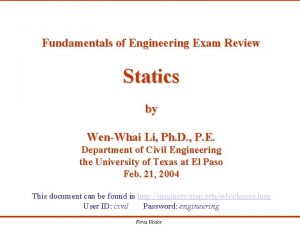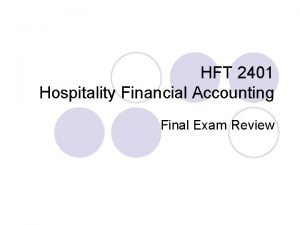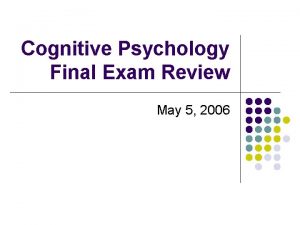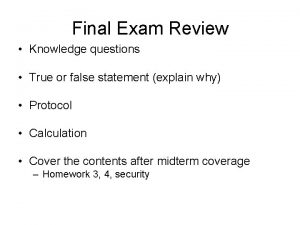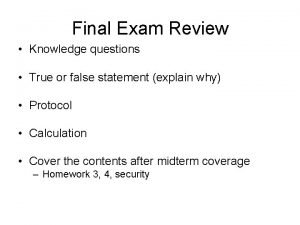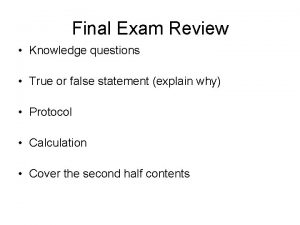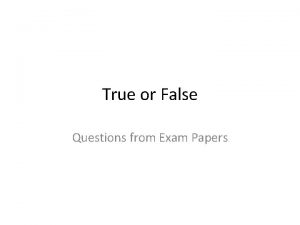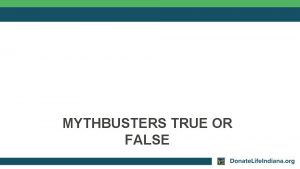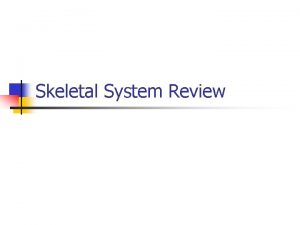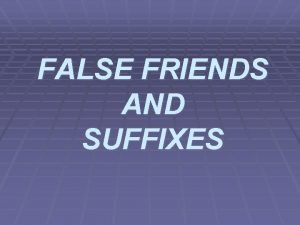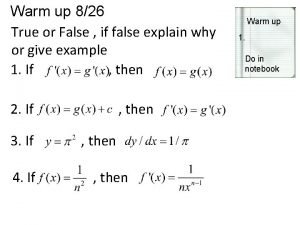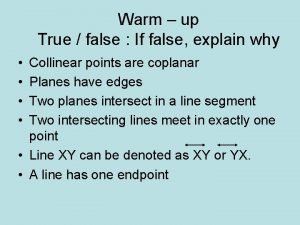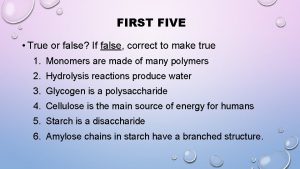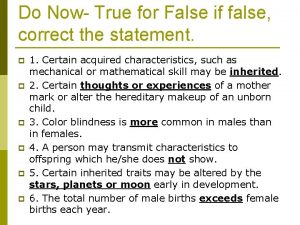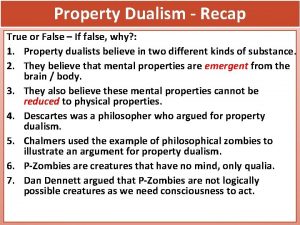Final Exam Review Knowledge questions True or false

























- Slides: 25

Final Exam Review • Knowledge questions • True or false statement (explain why) • Protocol • Calculation • Cover the contents after midterm coverage

Knowledge Question Examples • Three classes of switch fabric, speed relationship – What is Head-of-the-line (HOL) blocking? • Where can queue occur in router? • TCP header size? IP header size? UDP header size? • How many bits in IP of IPv 6? Address space size? Why it is very slow to be deployed? (enough IP space, hard upgrading and compatible) • Routing: what are Link state, distance vector? • Internet two-level routing? (inter-AS, intra-AS) • RIP, OSPF, BGP? Used where? – OSPF uses link state, BGP/RIP uses distance vector • Which is better? pure ALOHA, slotted ALOHA, CSMA/CD? – What are their assumptions? (collision detection, time syn) • CSMA/CD? CSMA/CA? Why wireless use CSMA/CA?

Knowledge Question Examples • • • Ethernet Broadcast MAC addr. ? What the broadcast address for? What is ARP? Why Ethernet is much better than aloha in efficiency? (homework 3) Hub vs. Switch? (homework 3) 802. 11 a, b, g: speed? Working frequency? 802. 15? (personal area network, example: bluetooth) Wireless no collision detection? – listen while sending, fading, hidden terminal • • Network security three elements: – Confidentiality, authentication, integrity What is public/symmetric key cryptography? Pro vs. con? Why use “nonce” in security? (replay attack) What is man-in-the-middle attack? Usage of firewall? (block outside active traffic to inside) IP spoofing? SYN flood Do. S attack? UDP flood? What is a botnet? Different between email virus vs. worm? – Vulnerability, user interaction to propagate, speed • IPSec vs. SSL? (different layers, tcp vs. udp)

Protocol Problem Examples • NAT address translation procedure • Digital signature procedure • HTTPS connection procedure – CA, public key • Secure email (assume known public key) – Confidentiality – Integrity

Calculation Examples • • • Homework 3 prob. 7 (subnet addressing) Homework 2, prob. 9 -11 (link state, distance vector) Homework 3, prob. 4 (parity checking) Homework 3, prob. 5 (CRC calculation) Homework 3, prob. 11 (wireless MAC protocol) Caesar cipher decrypt, Vigenere cipher, one-time pad decrypt (given the pad)

Three types of switching fabrics Property? Speed order?

• Head-of-the-Line (HOL) blocking: queued datagram at front of queue prevents others in queue from moving forward • Queue can occur at both input port and output port of a router

Intra-AS and Inter-AS routing C. b a Host h 1 C b A. a Inter-AS routing between A and B A. c a d c b A Intra-AS routing within AS A B. a a c B Host h 2 b Intra-AS routing within AS B • We’ll examine specific inter-AS and intra. AS Internet routing protocols shortly

Routing Algorithm classification Global or decentralized information? Global: • all routers have complete topology, link cost info • “link state” algorithms Decentralized: • router knows physically-connected neighbors, link costs to neighbors • iterative process of computation, exchange of info with neighbors • “distance vector” algorithms

NAT: Network Address Translation 2: NAT router changes datagram source addr from 10. 0. 0. 1, 3345 to 138. 76. 29. 7, 5001, updates table 2 NAT translation table WAN side addr LAN side addr 1: host 10. 0. 0. 1 sends datagram to 128. 119. 40. 186, 80 138. 76. 29. 7, 5001 10. 0. 0. 1, 3345 …… …… S: 10. 0. 0. 1, 3345 D: 128. 119. 40. 186, 80 S: 138. 76. 29. 7, 5001 D: 128. 119. 40. 186, 80 138. 76. 29. 7 S: 128. 119. 40. 186, 80 D: 138. 76. 29. 7, 5001 3: Reply arrives dest. address: 138. 76. 29. 7, 5001 3 1 10. 0. 0. 4 S: 128. 119. 40. 186, 80 D: 10. 0. 0. 1, 3345 10. 0. 0. 1 10. 0. 0. 2 4 10. 0. 0. 3 4: NAT router changes datagram dest addr from 138. 76. 29. 7, 5001 to 10. 0. 0. 1, 3345

Intra-AS and Inter-AS routing C. b a Host h 1 C b A. a Inter-AS routing between A and B A. c a d c b A Intra-AS routing within AS A B. a a c B Host h 2 b Intra-AS routing within AS B – RIP: Routing Information Protocol – OSPF: Open Shortest Path First – BGP: Border Gateway Protocol (Inter-AS)

ARP protocol: Same LAN (network) • • • A wants to send datagram to B, and B’s MAC address not in A’s ARP table. A broadcasts ARP query packet, containing B's IP address – Dest MAC address = FF-FF-FF-FF – all machines on LAN receive ARP query B receives ARP packet, replies to A with its (B's) MAC address – frame sent to A’s MAC address (unicast) • A caches (saves) IP-to-MAC address pair in its ARP table until information becomes old (times out) – soft state: information that times out (goes away) unless refreshed • ARP is “plug-and-play”: – nodes create their ARP tables without intervention from net administrator

What is network security? Confidentiality: only sender, intended receiver should “understand” message contents – sender encrypts message – receiver decrypts message Authentication: sender, receiver want to confirm identity of each other – Virus email really from your friends? – The website really belongs to the bank? Message Integrity: sender, receiver want to ensure message not altered (in transit, or afterwards) without detection – Digital signature

Collision Avoidance: RTS-CTS exchange A B AP DIFS RTS(B) RTS(A) reservation collision RTS(A) CIFS CTS(A) DATA (A) time defer CIFS ACK(A) Textbook Page 522 figure ACK(A)

Firewall • Block outside-initiated traffic to inside of a local network • Usually do not block any traffic initiated from inside to outside public Internet administered network firewall

Digital signature = signed message digest Bob sends digitally signed message: large message m H: Hash function Bob’s private key + - KB Alice verifies signature and integrity of digitally signed message: encrypted msg digest H(m) digital signature (encrypt) encrypted msg digest KB(H(m)) large message m H: Hash function No confidentiality ! KB(H(m)) Bob’s public key + KB digital signature (decrypt) H(m) equal ?

Secure e-mail q Alice wants to send confidential e-mail, m, to Bob. KS m KS K (. ) S + K+ B Alice: q q . K B( ) KS(m ) + Internet + KB(KS ) generates random symmetric private key, KS. encrypts message with KS (for efficiency) also encrypts KS with Bob’s public key. sends both KS(m) and KB(KS) to Bob.

Secure e-mail q Alice wants to send confidential e-mail, m, to Bob. KS m KS K (. ) S + K+ B Bob: . K B( ) KS(m ) + + KB(KS ) . K S( ) - Internet + KB(KS ) q uses his private key to decrypt and recover K S q uses KS to decrypt KS(m) to recover m KS - . K B( ) KB m

Secure e-mail (continued) • Alice wants to provide message integrity (unchanged, really written by Alice). m H(. ) KA - . K A( ) - - KA(H(m)) + + KA Internet m • Alice digitally signs message. m + . K A( ) H(m ) compare . H( ) H(m ) • sends both message (in the clear) and digital signature.

How SSL (https) works? Three-way handshake Request server certificate K-CA(K+B) KB+ Server B Client Certificate from CA K+B(KA-B) Symmetric session key KA-B(m) time

Distance table gives routing table E cost to destination via Outgoing link to use, cost B D A 3 5 8 A A, 3 B 5 4 9 B B, 4 C 6 9 4 C D, 4 D 4 11 5 D A, 4 Distance table destination A destination D () Routing table

Distance Vector Algorithm: example X 2 Y 7 1 Z Z X D (Y, Z) = c(X, Z) + minw{D (Y, w)} = 7+1 = 8 Y X D (Z, Y) = c(X, Y) + minw {D (Z, w)} = 2+1 = 3

CRC Example Want: D. 2 r XOR R = n. G equivalently: D. 2 r = n. G XOR R equivalently: if we divide D. 2 r by G, want remainder R R = remainder[ D. 2 r G ]

Dijkstra’s algorithm: example Step N 0 A 1 AD 2 ADE 3 ADEB 4 ADEBC 5 ADEBCF D(B), p(B) D(C), p(C) D(D), p(D) D(E), p(E) D(F), p(F) 2, A 5, A 1, A infinity, 2, A 4, D 1, A 2, D infinity, 2, A 3, E 1, A 2, D 4, E 5 A 1 2 B 2 D 3 C 3 1 5 F 1 E 2

• Caesar cipher decrypt: – “welcome”, key= +2 • Vigenere cipher – “final exam” key=3, 4, -1 (blank space does not change)
 True or false true or false
True or false true or false Ap gov review final exam review
Ap gov review final exam review World history spring final exam review answers
World history spring final exam review answers Spanish 1 semester 1 final exam answer key
Spanish 1 semester 1 final exam answer key Human body systems final exam
Human body systems final exam Poe final exam review
Poe final exam review Ied final exam review
Ied final exam review World history fall semester exam review
World history fall semester exam review Principles of business final exam answer key
Principles of business final exam answer key Spanish 2 review packet
Spanish 2 review packet Pa state tree
Pa state tree Ap world history final exam
Ap world history final exam Us history semester 2 final exam review
Us history semester 2 final exam review English 4 semester 2 exam
English 4 semester 2 exam Physics 20 final exam practice
Physics 20 final exam practice Physical science jeopardy
Physical science jeopardy Mat1033 final exam
Mat1033 final exam Statics exam 3
Statics exam 3 Zoology final exam review
Zoology final exam review Earth science final
Earth science final Algebra 1 semester 2 final exam
Algebra 1 semester 2 final exam Financial accounting final exam multiple choice
Financial accounting final exam multiple choice Personal finance final exam review
Personal finance final exam review Spanish 2 final exam
Spanish 2 final exam Psychology final exam review
Psychology final exam review True or false questions about seasons
True or false questions about seasons

















